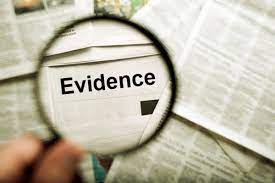Indications, evidence and evidence are concepts typical of the expert field. The three concepts have a very important relationship with each other, but they should not be understood as synonymous.
In a legal process, the relevance of these and how their condition can change is identified. In other words, what begins as a simple indication generates the search for evidence that could later be accepted as evidence.
What are the clues?
The clues are marks, traces, signs that offer clues about a fact. When investigating or beginning to search for a truth, the first thing that appears are these traces. They constitute a starting point for developing the first hypotheses about a case.
They are not enough to assert the existence of a commission of the crime or the circumstances in which it occurred. They only work as probable data to focus the search for the truth.
Types of clues
The indications have a probable relationship with the facts and need to be subjected to other analyzes for confirmation or rejection. In the first instance it is subjective elements.
By their structure they can be classified into different types.
- Physical: they are things that have a special use destination and are manageable.
- Chemicals: all natural or man-made substances.
- Biological: those that arise from human or animal tissues or fluids.
Other, more specific and relevant typologies for investigations and expert reports emerge from each of these types.
Examples of clues
- Buying a firearm.
- Presence at the scene.
- A motive that links a person with another affected by the crime committed.
- Previous threats.
What are the evidences?
Evidence is contrasted objects or signals that allow the elements or facts to be related. When talking about evidence, the certainty of a thing is determined. They can turn evidence into scientific arguments that confirm or reject the hypothesis on which they were working.
The basis for the preparation of expert reports is in the evidence. The more there are, there will be greater security in the truth that is trying to be verified. They are often confused with tests, but they are not the same, although they could become them.
Types of evidence
Although there are different types of evidence, the most important classification of evidence is based on its relationship with the facts investigated. Thus, there are two types:
- Determined evidence: are elements that have a relationship with the object or person that causes the event and are detected with the slightest ocular inspection or with the use of magnifying glasses. A clear example is a weapon at a crime scene.
- Indeterminate evidence: are those that by their nature require a complete and in-depth analysis to know their composition. An example is a drop of blood at a crime scene or a hair on a victim's fingernails.
Examples of evidence
- A weapon at the scene.
- Toxicological test.
- Hair, human skin at the location or on a found body.
What are the tests?
The tests are instruments used to verify the truth of the facts. In the legal field, they are understood as the evidence accepted by the judge as valid arguments and demonstrative facts.
The function of the test is to demonstrate responsibility or not for the act under investigation. It applies to both civil and criminal. Through the evidence, an attempt is made to generate in the judge a conviction of the existence of the facts that are being discussed.
Types of tests
As established by the Criminal Procedure Law, different means of evidence can be classified. These are:
- Confession: basically it is the confession of the people responsible and investigated for the fact.
- Witnesses: the testimony of witnesses proposed by the different parties, by the Public Prosecutor or called by the Court.
- Expert report: a document made by experts specialized in the matter of the fact under investigation. This report should be based on the greatest amount of evidence collected.
- Documentary evidence: all kinds of documents, books, papers and other elements that promote the clarification of the facts.
Difference Between Indications, Evidences, and Proofs
They are all an important part of a legal procedure and each one fulfills a function.
The indication is a perceptible element, material or not, that allows to deduce the existence of a certain circumstance in a fact. They are signs that allow a decision to be made about the path of investigation for the search for evidence.
Evidence is an element that has already been verified and allows the relationship between objects or people linked to the fact under investigation to be established with clarity and certainty.
The proof is the evidence accepted by the Judge or Court that serves as an argument to reach the level of conviction sufficient to reach a verdict.
Both indications and evidence can be used as evidence. In the former, the emphasis is placed, in a more subjective way, on a line of research. The latter determine the existence of the circumstances of the fact by themselves.
Conclusion
Indications, evidence and evidence are three elements that serve the investigation of a fact. Each of them is part of a moment in the process and has an influence on its course. Using the three terms as synonyms in the legal field is a mistake, although it happens frequently.
When it comes to finding the truth and reaching a sentence, it is necessary to demonstrate to the Judge or Court the existence of the fact and those responsible. This is why the tests are presented in their different types and must be accepted for their validity.
The tests arise from evidence, proven elements that determine the circumstances. The evidence arises, in general, from a search based on indications that allow formulating hypotheses. It is essential to respect the collection protocols so as not to be discarded.


No comments yet